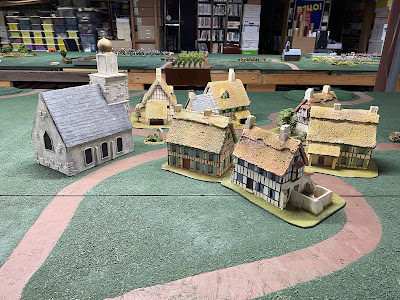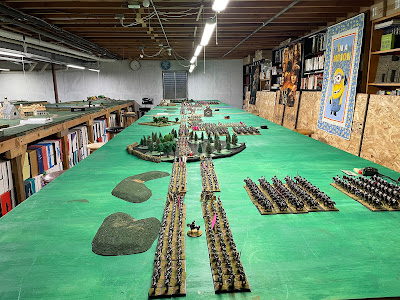 |
| The Battle of Lobositz at the Little Wars Convention, using BAR rules in Old School style wargaming. |
I recently read a blog that has taken a few swipes at "Imaginations Armies" and says that his way of doing things in wargaming is the best way. Several other blogs have carried a similar tune from time to time, so I thought tha a rebuttal of sorts was long overdue.
Well, it's ok to have your opinion, but we live in a big church - the wargaming community - and there are a lot of different ways of approaching the hobby of playing games with the Little Men, as our wives and sweethearts call them. As long as people are having fun playing wargames and socializing with like minded friends, what is the point of disparaging one form of wargaming over another?
* the majority of wargamers like to build historical armies and recreate historical battles on the table top. They might also (and often do) create fictional battles and scenarios for their table top wars. This is the lane that I choose to play in most of the time.
* an even larger community of wargamers dwell in the fantasy realm of Hobbits, orcs and dwarves and all kind of imaginable monsters and enemies. Not my cup of tea, but I recognize that this segment of wargaming is vastly larger than the historical miniatures segment.
* back in 2005 or there abouts, Patrick Lewis created a Yahoo Group titled "Old School Wargaming" ("OSW") that celebrated the "good old days" of wargaming with the likes of Donald Featherston, Peter Young, Charles Grant and Peter Gilder, among others. It also remembered some of the old figure ranges such as Suren, Spencer Smith, RSM, Minifigs, Heritage, and Connoisseur, among others.
 |
| The Battle of Mollwitz, an old favorite from The Wargame book by Charles Grant. Suren Uhlans de Saxe clash with Stadden Black Hussars. |
 |
| Another cavalry scum at Mollwitz featuring Hinchcliffe Austians and Elite Miniatures Prussians. Note the use of single stand figures mounted on movement trays, or sabots, paying homage to the Old School style of single mounted figures in Peter Young's Charge book and rules. |
The Origins of Old School Wargaming and Imaginations
OSW brought back memories of the imaginery armies created by Peter Young and Charles Grant and books such as "The Wargame" by Charles Grant and "Charge" by Peter Young. People remembered cutting their wargaming teeth on these books and many a fond memory was dredged from our memories from those early days of the 1960s and 1970s. I think that the main attractions of wargaming in the Young-Grant style are the large regiments of big, easy to see 30mm figures and the kinder, gentler style of interaction amongst the players.
The Old School Wargaming movement brought a lot of people into the realm of 18th Century wargaming, and the Seven Years War in particular. They began to build imaginery armies, just like those of Charles Grant, that might have represented fictional countries, but they were firmly based in the era of tricorn hats, coats with turnbacks and a rather gentlemanly approach to wargaming that emphasized courtesy, corgiality and a sense of fair play. This was all good.
Somewhere along the line, someone applied the name "Imaginations" to all of the fictional countries, kingdoms, dukedoms and principalities that gamers had developed. The name stuck and now a days when wargamers hear the word "imaginations" it conjures up wargaming in the manner of Young and Grant.
Let me be clear in my opinion, Old School Wargaming and Imaginations brought a lot of new people into the world of 18th Century wargaming and anything that expands the populace of 18th Century wargaming is a very, very, very good thins. Period!
Batailles dans l'Ancien Regime Rules Are Developed
Circa 2007, I was attending the Seven Years War Association Convention in South Bend, Indiana and I was hosting some sort of conventional SYW game featuring Austrians and Prussians. On the table next me was a game hosted by Bill Protz that featured large battalions of 48 and 60 figure battalions of soldiers fighting in three ranks, just like they did in the SYW. Bill was running a French and Indian War game at the time. As my game progressed, I found that I kept peering over at Bill's game table to watch these "Big Battalions" fight it out on the table top
After our prospective games had concluded, I walked over to Bill Protz and told him how interested I was in his wargame and discovered that Bill's game and rules were strongly influenced by Peter Young and his book "Charge". As the conversation continued I got around to asking Bill the question, "have you ever considered building armies for the European theatre of the Seven Years War and using your big battalions for wargames?"
Well, like minds converged and we agreed that it would be a good idea for us to get together and try some games in the European theater of the SYW. I began painting Prussian battalions of 60 figures and cavalry squadrons of 12 figures. Bill began adding cavalry to his existing French and British armies. After several months of painting we collectively had enough big battalions on hand to fight a decent SYW battle on Bill's large 6ft by 24ft table.
Paying homage to messers Young and Grant, we created fictional nations for our armies. Bill had an afinity for the French army and so his "imagination" was called "Gallia". I countered with a country called "Germania" (or Geraniums as Hal Thinglum called it). My own particular country was called Hesse Seewald, a small country that modeled its army after the Prussian army. As a matter of fact, all of my infantry battalions and cavalry regiments were painted and flagged as Prussian regiments. They just happened to be fighting under the banners of Germania or Hesse Seewald.
 |
| The Napoleonic Battle of Aspern-Essling fought as an imaginary SYW battle between Gallia and Germania. |
 |
| The happy band of brothers playing an Old School style game of Imaginations. |
 |
| The town of Aspern decorated with old style Ian Weekley buildings and a newer church built by Herb Gundt |
 |
| Big 60-figure cavalry regiments at Aspern-Essling. |
Where does the name Hesse Seewald come from" I live in a town called Lake Forest so Lake = See and Forest = Wald, thus Seewald would, in theory, be a German name for Lake Forest. It seemed like there were many German principalities that were called Hesse-this or Hesse-that so I added the word Hesse to Seewald and created the fictional country of Hesse Seewald.
Rules for Playing With Big Battalions
We fought our battles using Bill's "Drums of War Along the Mohawk" rules for the French and Indian War. The rules use a figure to man ratio of 1:10, meaning that one wargame figure represents ten actual men. We played a lot, and I mean a really large lot of wargames with these rules, tweaking and adding things here and there. Over the course of several years, we had developed a really nice set of 18th Century wargame rules and I encouraged Bill to publish his rules.
Bill did indeed publish the rules under the name "Batailles dan l'Ancien Regime" or Battles in the Ancien Regime (which is what France was called prior to the advent of the French Revolution. We needed an acronym for the rules because it had a rather long name, so we settled on "BAR" for short. From 2005 to 2010 we staged many battles between Gallia and Germania. Following the admonishement of Peter Young, we celebrated our victories by bestowing battle honors to the winning armies and gluing wooden plaques to monuments to celebrate our wins. Battles were named after Donald Featherstone, Peter Young, Charles Grant and other pioneers of the wargaming hobby from the 1960s and 1970s.
 |
| Historicon Game hosted by Protz, Frye & Purky |
 |
| Big battalions, Winter terrain and Imaginations armies add up to a whole lot of FUN! |
We must have garnered some attention to the 18th Century, because Bill sold a lot of sets of his rules and people all across the USA were building BAR armies. Bill had the honor of being invited to a convention in Texas and helping to run a BAR game at the convention. In 2007 as I recall, Historicon invited Bill Protz and I as special guests of the convention given that the theme of the year was the 18th Century Warfare. We ran 3 or 4 games in the front lobby of the hotel and conducted a seminar on infantry tactics (we pushed a bunch of our battalions together to create two 600 figure battalions of French and Prussians so that people could see how long a battalion was and how hard it might have been to maneuver such a battalion. That was a really cool thing to see.
Above all, WE HAD FUN!
My Style of Imaginations & Old School Wargaming
Many of my forces were built using 30mm Stadden and Suren figures, as featured in Charles Grant's book, The Wargame. I also used RSM figures, some Elite Miniatures, Old Glory and Front Rank figures. I had fun building my Prussian/Germanian/Hesse Seewald army with these figures. At one time I had as many as 20 battalions of 60-figure Prussian battalions, but over the years I have reduced my army to about 12 battalions (about the amount of figures that I can carry in the trunk of my car to a wargame at Bill Protz's house).
On at least four occasions I organized and hosted large mega-games at a local hotel for our SYW games. We played SYW versions of Rossbach, Gettysburg, Aspern-Essling and Austerlitz with our BAR armies and had 20+ players in each game. It was really amazing to see so many troops spread across two or three 6ft wide by 20 feet long game tables. I was always enamored with Peter Gilder's Wargame Holiday Center and Grand Manner style of gaming, and this is what I attempted to recreaate in these large games. All were fought under the Imaginations banners of Gallia and Germania.
So I have nothing but warm feelings about Imaginations armies and wargames. I caught the wargaming bug, and the SYW bug in particular, from messers Grant and Young. If Imaginations were good enough for them, they are good enough for me too.
Conclusion
The concept of Imaginations has attracted a lot of gamers to the SYW era of historical minatures wargame. Anything that brings in new people to the hobby is something that should be celebrated, rather than disparaged.
As I said earlier, there are a lot of different approaches to the hobby and the diversity of ideas on how to wargame is one of the things that make this such a great hobby to pursue.
























